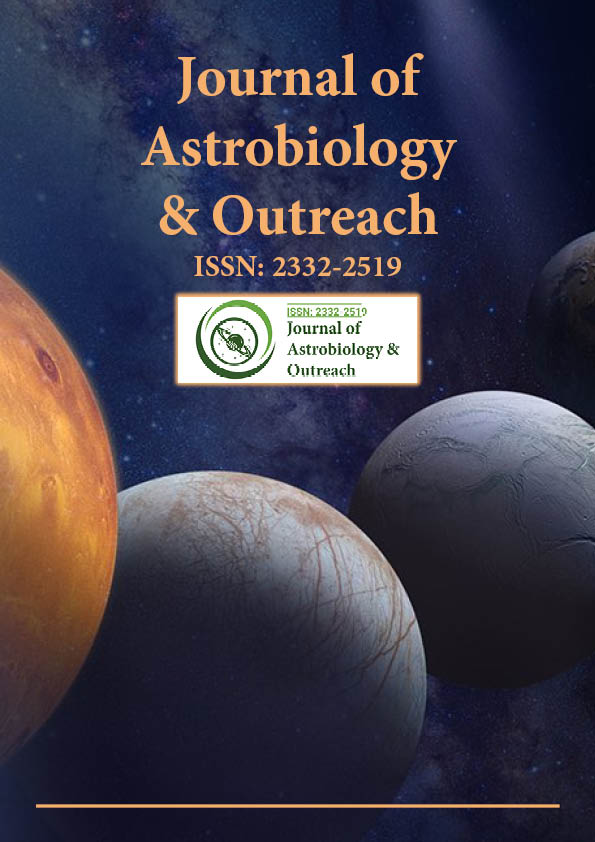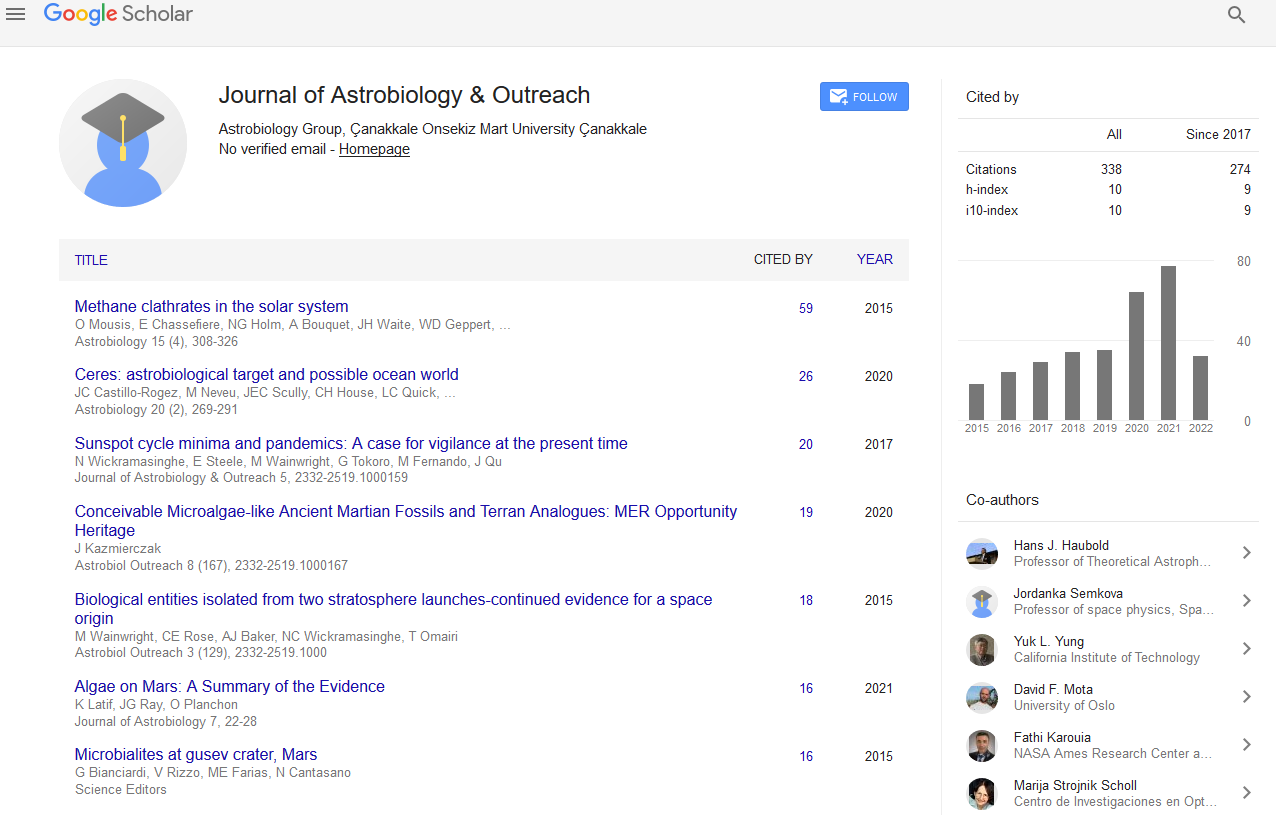Indexed In
- Open J Gate
- Academic Keys
- JournalTOCs
- RefSeek
- Hamdard University
- EBSCO A-Z
- OCLC- WorldCat
- Google Scholar
Useful Links
Share This Page
Journal Flyer

Open Access Journals
- Agri and Aquaculture
- Biochemistry
- Bioinformatics & Systems Biology
- Business & Management
- Chemistry
- Clinical Sciences
- Engineering
- Food & Nutrition
- General Science
- Genetics & Molecular Biology
- Immunology & Microbiology
- Medical Sciences
- Neuroscience & Psychology
- Nursing & Health Care
- Pharmaceutical Sciences
Commentary - (2024) Volume 12, Issue 2
Astrobiology on Solar Sails: LightSail Mission's Vision for Sustainable Space Exploration
Mark Abbott*Received: 28-May-2024, Manuscript No. JAO-24-27362; Editor assigned: 31-May-2024, Pre QC No. JAO-24-27362 (PQ); Reviewed: 14-Jun-2024, QC No. JAO-24-27362; Revised: 21-Jun-2024, Manuscript No. JAO-24-27362 (R); Published: 28-Jun-2024, DOI: 10.35248/2332-2519.24.12.341
Description
The LightSail Astrobiology Precursor Mission represents an innovative approach to exploring space and advancing astrobiology, control solar sailing technology to beyond Earth’s immediate vicinity. This mission aims to gather critical information on how microorganisms could survive the challenges of outer space. Solar sail technology, although still emerging, offers a cost-effective and efficient means to propel spacecraft without traditional fuel sources. By relying on sunlight pressure, this mission utilizes an energy-efficient source, allowing extended and affordable travel in space. Solar sailing relies on photons from sunlight to exert slight pressure on a reflective sail surface. Though the force is minimal, it gradually accelerates the spacecraft in the vacuum of space. Over time, this force generates momentum, enabling the spacecraft to reach high speeds without a need for continuous fuel. For missions targeting distant regions, solar sails provide a potential method to travel farther than conventional spacecraft while keeping costs low.
The LightSail Astrobiology Precursor Mission uses this technology to investigate whether life can endure in the unique conditions of space. Exposing biological samples to outer space is an exceptional and valuable scientific method for studying astrobiology. Experiments on Earth and the International Space Station indicate that certain microorganisms can survive intense radiation, microgravity and other extreme conditions. However, studying microorganisms on this solar sail mission, with prolonged exposure to solar radiation and cosmic rays, could provide new insights into how life might persist in space and on other celestial bodies. A central aim of the mission is to examine the resilience of particular microorganisms. Some microbial life forms, especially extremophiles, are known to survive in some of Earth’s most hostile environments, such as deep-sea vents, high-radiation zones and frozen tundras. These organisms are of significant interest because they may offer clues about how life could exist elsewhere in our solar system or on exoplanets. The LightSail mission would expose selected microbes to space, gathering data on how long they can endure and what types of molecular or cellular changes they undergo to adapt to space’s challenging conditions.
If certain microorganisms prove able to survive extended exposure to space, it might support the theory that life could spread across planets and moons via meteoroids and comets. Known as panspermia, this theory suggests that life could travel between planetary systems, possibly seeding life in different regions of the galaxy. While panspermia remains a hypothesis, the LightSail mission could provide data to either support or challenge this idea. The LightSail Astrobiology Precursor Mission also serves as a platform to study how biological materials react over extended periods in space, providing insights valuable for future human space exploration. As we prepare to explore Mars and even consider more distant destinations, understanding the effects of long-term exposure to space conditions on biological organisms is essential. The health risks posed by cosmic radiation and the absence of atmospheric protection must be addressed. Microorganisms on the LightSail mission could provide baseline data for future studies, helping to inform methods to protect biological materials from these risks, thus supporting safer human space travel.
In addition to its scientific goals, the mission has generated significant public interest, especially with its focus on solar sail technology. Solar sails hold great potential for future missions that might one day reach interstellar destinations. Unlike conventional rockets, which burn fuel rapidly and require substantial resources to launch and operate, solar sails provide a sustainable way to travel vast distances over time. As photon pressure builds over long distances, solar sails could theoretically enable missions to cross interstellar space, potentially reaching nearby star systems within human lifetimes. This mission is also a step forward in experimenting with miniaturized spacecraft. By designing compact, lightweight systems, scientists can conduct numerous small-scale experiments without needing large, heavy space probes. This approach aligns with recent trends in space exploration, where technology miniaturization allows for more frequent, cost-effective launches. The flexibility offered by smaller spacecraft, like the LightSail, is attractive for a wide range of missions, from planetary exploration to interstellar astrobiology studies.
The development of solar sail technology on this mission also carries broader implications for environmental sustainability in space travel. Traditional space missions, especially those relying on chemical propulsion, have a considerable environmental impact due to fuel production, emissions and waste. Solar sails eliminate the need for conventional fuels, reducing pollution and minimizing waste. For long-term space exploration, solar sail technology may serve as an environmentally friendly alternative to traditional propulsion methods, offering a sustainable approach to space travel. The LightSail Astrobiology Precursor Mission brings together solar sail technology and astrobiology experiments to expand our understanding of life’s potential resilience in space. By observing how microorganisms react to the unique conditions of space, scientists can gain insights into life’s endurance, contributing valuable knowledge to both theoretical and practical aspects of space exploration. The mission’s impact stretches from advancing knowledge of potential life beyond Earth to developing sustainable, efficient methods of space travel. As technology and our knowledge of space evolve, the LightSail mission offers an important step in understanding the possibilities and limitations of both biological and technological resilience in space.
Citation: Abbott M (2024). Astrobiology on Solar Sails: LightSail Mission’s Vision for Sustainable Space Exploration. J Astrobiol Outreach. 12:341.
Copyright: © 2024 Abbott M. This is an open-access article distributed under the terms of the Creative Commons Attribution License, which permits unrestricted use, distribution, and reproduction in any medium, provided the original author and source are credited.

